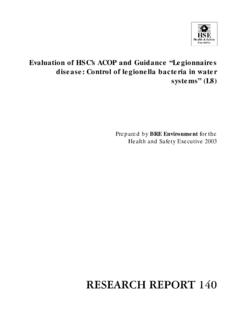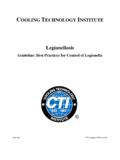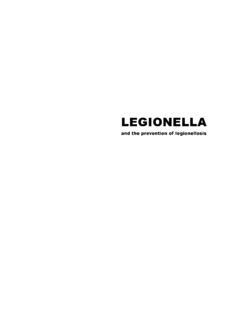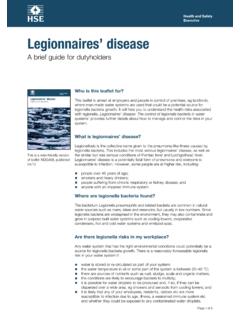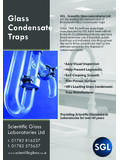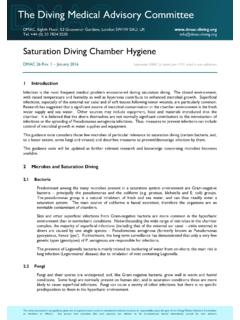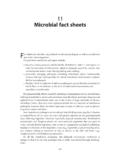Transcription of Legionella
1 An Overview of Legionella AnalysesBy Diane Miskowski, MPHEMSL Analytical, Inc. October 2014 BackgroundThe first recognized outbreak of Legionnaires Disease occurred in the US at the American Legion Convention in Philadelphia during the summer of 1976. There were several hundred people who were stricken. Thirty four people died from the disease. As a result of the efforts of the US Centers for Disease Control (CDC), this was the first time the bacteria was cultured and identified. Earlier outbreaks of the disease went undiagnosed. Since that time, there have been many identified outbreaks in this country and abroad prompting professional organizations and health departments worldwide to implement guidelines for diagnosing and reporting the disease, and monitoring the and EpidemiologyUbiquitous in all aquatic environments, Legionella bacteria are found in groundwater as well as fresh and marine surface waters.
2 The bacteria enter our plumbing systems, whirlpool spas, and cooling towers via these water sources. Unless control measures are conducted properly and routinely, the biofilm, scale, and corrosion that builds up over time in these systems will protect the organism and allow it to aerosolized water from cooling towers, whirlpool baths, nebulizers, faucets, and showerheads becomes airborne. When a susceptible host inhales the contaminated aerosol, legionellosis can occur. Legionella can cause a severe form of pneumonia (Legionnaires Disease) often accompanied by serious long term health effects, or the mild flu-like illness called Pontiac Fever. Other infected organs, and asymptomatic infections may factors include age, gender, compromised immune systems, and pre-existing medical conditions such as chronic obstructive pulmonary disease, cancer, and diabetes.
3 Men over 50 years of age who are heavy smokers and drinkers are at greatest risk. However, there have been cases of the disease in healthy, younger people. Pre-mature, immuno-compromised, or ventilated neonates are also at risk from hospital acquired infection. For these reasons, many state health departments have guidelines that recommend routine monitoring of Legionella in critical care hospitals and nursing home the disease is under-reported, travel (cruise ships), hotel, and resort related outbreaks are reported each year. These are mostly associated with the use of whirlpool spas. While community-acquired outbreaks involving cooling towers and whirlpool spas receive the most media attention, studies indicate that building potable water sources account for most of the infections.
4 This is particularly true in hospitals and nursing homes where there are large numbers of immunosuppressed or critically ill people. For these reasons many state health departments have guidelines that recommend routine monitoring for Legionella . In August, 2014 the Veterans Administration (VA) developed a directive that requires all VA locations that have overnight care to implement monitoring in their potable water systems. There are also draft guidelines for the prevention of Legionellosis in building water systems that were created by the American Society of Heating, Refrigeration and Air Conditioning Engineers (ASHRAE). Choosing Sampling MethodsProper methods for collecting and analyzing samples are necessary to ensure defensible results.
5 Since the bacteria in water are present in very low levels, 1000 mL potable water samples are recommended by the US Public Health Centers for Disease Control (CDC). This sample size allows for the bacteria in the water to be concentrated, allowing for a more sensitive detection and quantitation limit. Many professional guidelines recommend semi-annual sampling for potable water non-potable water sources such as cooling tower water, a 250 ml sample size is sufficient. Professional guidelines suggest these sources be monitored should be conducted in a way that maximizes recovery of the organism and mimics the route of exposure. Legionella samples should be collected wherever water aerosolization may occur. Sampling water alone, however, will likely miss the real source of the organism.
6 This actual source is the biofilm or slime that is often found in our plumbing systems, cooling towers, and whirlpool baths. Biofilm consists of other bacteria , blue green algae, amoeba, and protozoans. Biofilm protects Legionella from direct exposure to ultra-violet (UV) light, desiccation, and the chemicals used to control its growth. In addition, the Legionella bacteria are ingested by the protozoans and amoeba and will continue to multiply inside these organisms. Once these organisms die large numbers ofLegionella bacteria will be released into the surrounding environment. Because biofilm protects the organism and enhances Legionella multiplication, incorporating swabs in your sampling protocol is very important.
7 Swab sampling of biofilm found in cooling tower sumps, potable water faucets, showerheads, and whirlpool spa filters is necessary to obtain a true picture of the presence of Legionella . Very often, biofilm swab samples demonstrate the presence of Legionella undetected by water sampling alone. While collecting air samples for Legionella mimics the route of exposure, it is generally not recommended for routine monitoring purposes. Legionella are unlikely to survive the exposure to UV light and desiccation for long periods of time. During air sampling, the bacteria likely are killed from the impaction of the bacterial cells on the collection taking samples a high efficiency particulate respirator, safety glasses, and gloves should be worn.
8 Take care not to generate any aerosols when collecting the samples. Only sterile, appropriately preserved bottles and swabs obtained from your lab should be used. Potable water bottles should be preserved with sodium thiosulfate to neutralize chlorine in the water sample. These preserved bottles should also be used when collecting water from cooling towers that have been treated with chlorine or bromine collecting a water sample, be sure to leave an air space in the bottle. Since Legionella require oxygen for their survival, an air space in the bottle will ensure that aerobic conditions are maintained during shipment to the lab. Samples should be packed and shipped to minimize the multiplication of non- Legionella bacteria .
9 Using an insulated cooler with freezer packs is recommended to avoid temperature extremes during shipping Samples should be shipped overnight to the Methods- Culture is the Gold Standard WorldwideLegionella are aerobic, fastidious bacteria ; they have very strict requirements for growth. Two of these requirements are iron and L. cysteine. They are weakly gram negative and grow slowly compared to other bacteria . Legionella are often overgrown by faster growing bacteria and can be inhibited by some bacteria . Legionella will not grow on standard microbiological media used for aerobic plates or for detecting other bacteria . For this reason labs should use methods that are selective for isolating and identifying the the definitive method worldwide for identifying Legionella in clinical and an environmental samples is the culture method.
10 This method uses an improved procedure developed by the CDC when it first isolated the organism after the American Legion outbreak in Philadelphia in 1976. The method uses buffered charcoal yeast extract agar (BCYE) as the base formulation. For potable water, the samples must be concentrated in order to enhance the quantitation limit. This is usually done by filtering the entire 1000 ml through a sterile membrane filter. The filter is then vortexed in 5 mL of sterile, distilled water. Aliquots are then taken of this distilled water for plating onto 6 different formulations of BCYE agar. Non-potable water often has a large concentration of bacteria that surpasses or inhibits the growth of Legionella .
